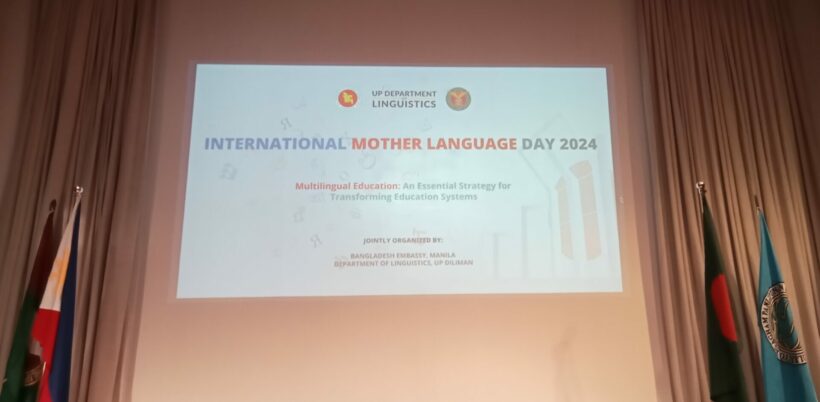“Educational systems usually have a combination of humanistic and pragmatic rules and objectives. We seek the development of happy children because we want them to be happy adults, and happy adults don’t really start wars, and don’t really hurt other people. This is a simple way of really advocating for peace, and language is important to that.” — Prof. Dina Joana S. Ocampo, Ph.D.
In celebration of the International Mother Language Day 2024, the University of the Philippines Department of Linguistics in partnership with the Embassy of Bangladesh to the Philippines expanded the horizons of multilingualism in education and embraced cultural and linguistic diversity through a symposium on February 21, 2024.
This year’s symposium theme is “Multilingual Education: An Essential Strategy for Transforming Education Systems,” and was held at the UP NISMED Auditorium.
Prof. Dina Joana S. Ocampo, Ph.D. was the symposium’s keynote speaker– a Professor at UP College of Education, former Dean of the same College from 2010 to 2013, and former Undersecretary for Curriculum and Instruction at the Department of Education (2013-2017). The event was also attended by the Ambassador of Bangladesh to the Philippines, His Excellency F.M. Borhan Uddin. Ms. Signe Poulsen, United Nations’ Senior Human Rights Advisor, was present as the representative of Mr. Gustavo González the United Nations Resident Coordinator and Humanitarian Coordinator.
Introduction to Multilingual Education

Prof. Dina Ocampo briefly discusses one of the ways to prepare for a multilingual classroom strategy.
The Multilingual Education (MLE) program has been influenced by cognitive, developmental, and cultural factors; slowing down its implementation is perhaps primarily driven by social, political, and economic agents. For Prof. Dina Ocampo, slowing it down only means that “there will be a child who speaks a language different from the language used in school, who is not getting a fair chance at learning; and learning delays will compound over time.”
“Language diversity is intertwined with bio and human diversity, to protect one is to protect the other,” Prof. Dina stated. Thus, the integration of the mother languages in the learning instruction does not only help to preserve students’ languages but to help them learn effectively and efficiently as well.
She emphasized the primary objective of multilingualism in education, to “… seek the development of happy children because we want them to be happy adults; and happy adults don’t really start wars, and don’t really hurt other people. This is a simple way of really advocating for peace, and language is important to that.” This statement is rooted in the collective desire of everyone to have societies and communities that are free, inclusive, and fair to all.
Nations struggle to convert establishing the conventions on human rights, children’s rights, and laws that respect indigenous learners into action because it challenges the linear thinking of nations about education. Thus, embracing MLE forces nations to create actual programs rather than just merely observing; and drive them against “one size fits all” solutions and approaches that are tailored after industrial or factory models of developing knowledge, skills, and values.
Advantages of Multilingual Education
Multilingual education improves learning. Research shows that bilingual and multilingual education is one of the variables that transcends children into learning beyond what the usual basic education curriculum provides. MLE has transformed learning at a low cost. Countries like the Philippines, South Africa, Papua New Guinea, Bangladesh, and others have found that minority language speakers and indigenous learners improved retention through MLE with manageable costs. In a country with limited resources, such as the Philippines, leveraging languages to meet the learning outcomes is advantageous.
The use of learners’ home language in their schools helps them learn. Prof. Dina Ocampo has presented that in a study, learners who use their home language in classroom instruction have attained higher test scores compared to the classrooms that do not use the mother tongue of the learners. This is evidence that shows that the native tongue of the learners serves as a link to learning.
Multilingual education supports inclusive and culturally appropriate education. Schools that operate bilingual or multilingual education like in Guatemala have attained higher attendance and promotion rates with lower repetition and dropout rates. Local studies in the Philippines show learners’ eagerness to participate in discussions when they are free to use their language and express themselves. In a study conducted by the team of Prof. Dina Ocampo with IP (indigenous people) elders, they have identified these 3 significant markers of language appreciation: it reinforces cultural identity, increases self-esteem, and improves the learning of other languages. Such findings present how indigenous people appreciate the use of mother languages.
Starting with the students’ mother tongue helps them to learn the target languages in school. In a parents’ consultation that Prof. Dina Ocampo organized, the parents wanted their children to learn English because it is the language of economic mobility, although they are also interested in learning their languages which includes the different languages in the Philippines. This aspiration of Filipino families to learn languages is recognized; thus, learning the target language with their mother languages will aid learners to be better at learning subsequent languages.
Steps in Implementing a Sound Multilingual Education
Policymakers should develop inclusive policies. These policies must be learner-centered as it has always worked for learning development. Checking the policies and ensuring that they contribute to child development appropriately is relevant. These policies must also be well disseminated and explained because in most nations it is not understood which results in demands and requisites are not met. On the other hand, one policy does not make the cut, but a constellation of policies to support the main policy can. For example, implementing the MLE Program cannot stand alone because it requires a policy for teacher development, a policy for instructional materials development, a policy for the budget, and so on. This will transform the policies into an operational system.
The integration of linguistics in language and literacy is necessary. At least in the Philippines, not all of its languages have a linguistics guide for teachers that will be the basis for the construction of reading programs for their schools. So if the Philippines has 187 languages, there should be 187 linguistics guides as well. Linguistics guides will help teachers to navigate teaching phonology, morphology, syntax, and so on of a specific language among learners. This calls for a stronger collaboration between teachers and linguists to produce authentic language-learning materials.
Plan the programs to be implemented with the stakeholders, particularly, when it comes to languages because they are not owned by anybody except those who speak it. Therefore, programs should be tailored according to those who speak the language. In other words, it should be imagined: what are the things to implement, how they can be delivered, and so on. Collaboration and consultation among teachers, school institutions, language users, and others concerned are valuable in the process to localize, contextualize, and bridge the gaps of MLE. A digestible timeframe for its implementation is necessary because the programs have to undergo a long process of deliberation before it is approved, especially when it comes to the budget allotment.
Establish a system of monitoring and evaluation of the programs implemented. The primary challenge of the MLE program is anchored on confused accountability and insistence on national reporting only. It should not be difficult to identify who is accountable for a certain responsibility— stakeholders must be able to say that teachers, principals, and schools are accountable for reporting to the community about the learning of the children. Aside from this, reports are primarily sent to the national level; however, immediate localized reports are necessary as well to provide immediate solutions to challenges that the learners encounter.
Multilingual Education Strives for Social Justice
Prof. Dina Ocampo has also acknowledged that poverty has a great impact on teaching and learning. She uttered, “No matter how colorful the textbooks are, if the child is not there because the child has to work, then the child is not learning”. This is a community concern that should not be disregarded in any education discussions. She also argued that MLE should be part of the education budget. She cited Jeffrey Sachs, one of the leading voices that promotes MLE, that Multilingual Education should be part of the criteria defining quality education because strong evidence from various studies supports it. It further suggests that “financing of education is a key element in oiling the strategies to obtain good education program implementation”. Bottomline, it is necessary to convince governments to employ MLE bolstered with research evidence and make sure that there is a sufficient budget for it.
Prof. Dina Ocampo ended her speech by stating that, “while working for multilingual education, there are many forces that are hindering or allowing us to progress in terms of serving the children. But we must remember that education is not the end— it is not an end in itself. What we are truly striving for is social justice”. She made a call to action that everyone should work towards rectifying persistent problems, acknowledge poverty has an impact on learning, utilize interventions to reduce hunger from the marginalized, and more importantly have restorative justice in education. Prof. Dina Ocampo firmly believes that mother tongue-based education, multilingual education, or in any model or form is a strategy toward achieving restorative justice in education so that every child gets a fair chance to overcome poverty and ignorance.
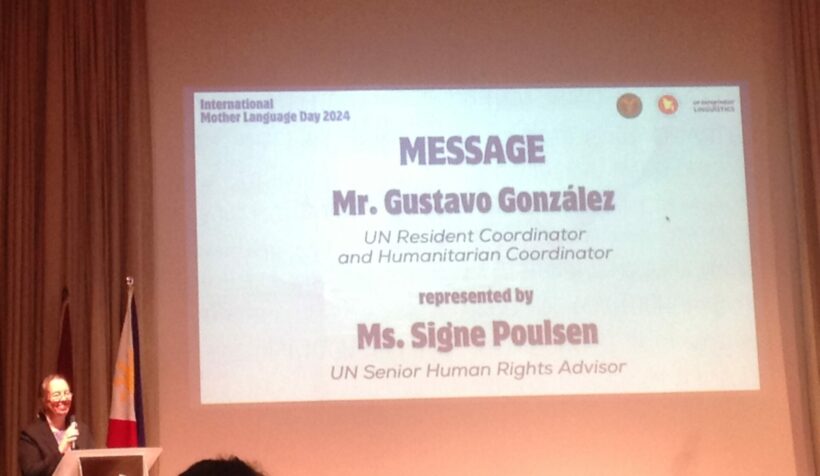
UN Senior Human Rights Advisor, Signe Poulsen giving her message about MLE on the international lense.
Afterwards, Ms. Signe Poulsen (UN Senior Human Rights Advisor) on behalf of Mr. Gustavo González gave a special message that encapsulates MLE as a preserver of rich cultures and heritage, and a doorway of opportunities. Ms. Poulsen also highlighted that about 40% of the global population lack access to education in their native language, and in some regions, the situation is much worse which resulted in the lack of mastery in language and literacy skills. That is why implementing mother tongue-based multilingual education is an important strategy that could serve as an accelerator for policymaking in education.
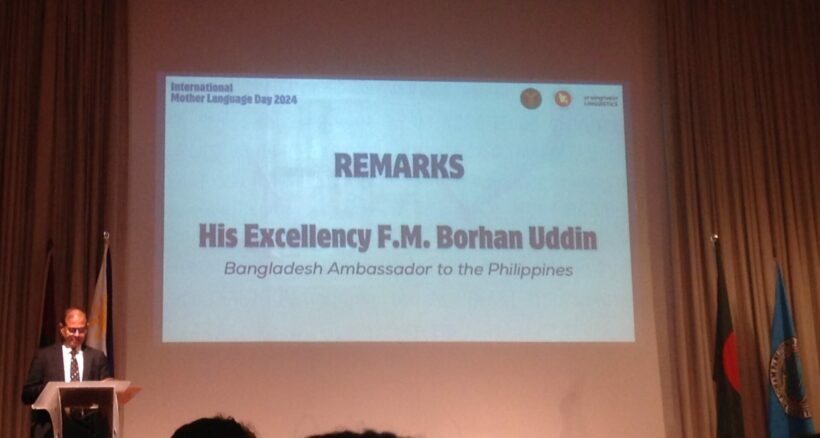
His Excellency F.M. Borhan Uddin discussing the history of IMLD.
His Excellency F.M. Borhan Uddin, commemorated the language martyrs of Bangladesh who fought for their native language to have a space today. Ambassador Uddin also briefly discussed the history of how Pakistan announced that Urdu would be their official language yet Bangla is the language that 54% of their population speak. Thus, the Language Movement in East Pakistan emerged and then the rest is history.
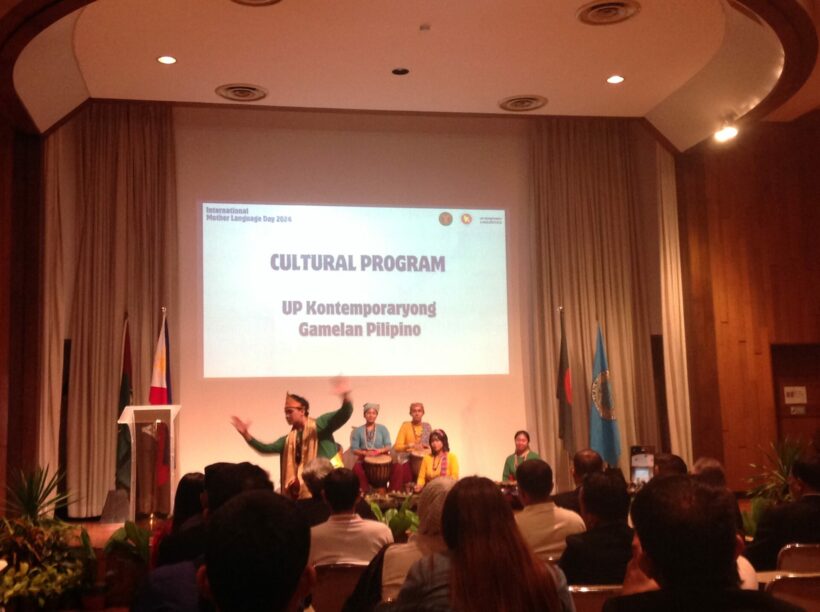
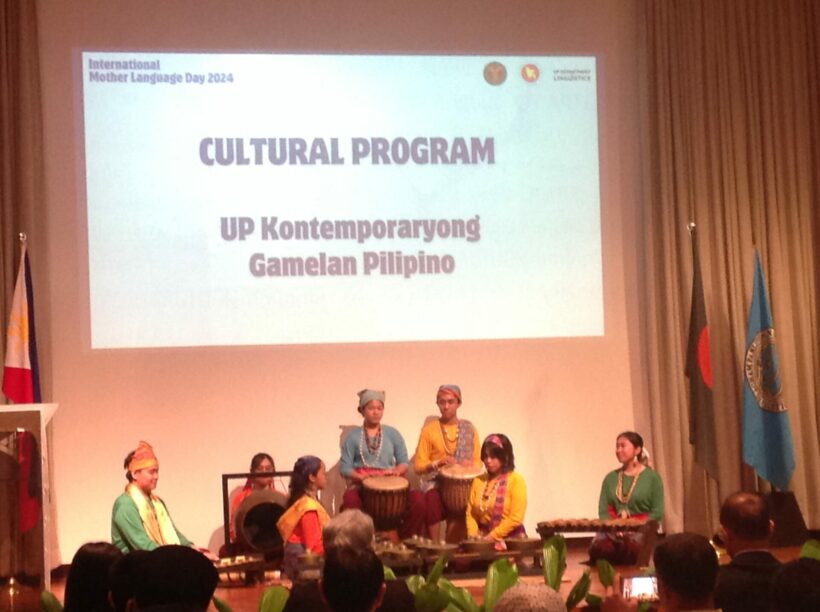
The symposium ended with cultural presentations prepared by UP Kontemporaryong Gamelan Pilipino of the College of Arts and Letters that celebrate the diversity of culture and heritage of the country. Captivating presentations through a variety of chants and ensembles using indigenous instruments left the attendees in awe.
Multilingual education is more than just a strategy. It is a bridge that connects people and an opportunity to fill the gaps in education and achieve restorative justice. Languages are essential in education, allowing learners to start with their native language where they can understand and express freely, will lead to the learner’s enhanced mastery of the target language. However, authorities have to assume the responsibility for developing appropriately inclusive policies, implementing programs, and budget security for the children to have a fair chance of learning. Multilingual Education is also a subtle approach in restoring the nation and its people, and when people are on the right track, a peaceful, inclusive, and fair society is produced.


